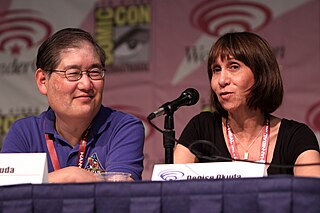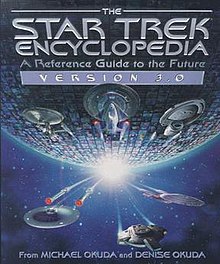
Star Trek: The Animated Series (TAS) is an American animated science fiction television series created by Gene Roddenberry. It originally aired under the title simply as Star Trek, subtitled Created by Gene Roddenberry, on Saturday mornings from September 8, 1973, to October 12, 1974, on NBC, spanning 22 episodes over two seasons. The second series in the Star Trek franchise, it features mostly the same characters as Star Trek: The Original Series. Set in the 23rd century, the series follows the further adventures of the Starship USS Enterprise as it explores the galaxy.

Dr. Leonard H. McCoy, known as "Bones", is a character in the American science-fiction franchise Star Trek. McCoy was played by actor DeForest Kelley in the original Star Trek series from 1966 to 1969, and he also appears in the animated Star Trek series, in six Star Trek films, in the pilot episode of Star Trek: The Next Generation, and in numerous books, comics, and video games. A decade after Kelley's death, Karl Urban assumed the role of McCoy in the Star Trek reboot film in 2009.

The Ferengi are a fictional extraterrestrial species in the American science fiction franchise Star Trek. They were devised in 1987 for the series Star Trek: The Next Generation, played a prominent role in the following series Star Trek: Deep Space Nine, and have made brief appearances in subsequent series such as Star Trek: Voyager, Star Trek: Enterprise, Star Trek: Discovery, Star Trek: Lower Decks and Star Trek: Picard.

Hikaru Kato Sulu is a fictional character in the Star Trek media franchise. A member of the crew in the original Star Trek series, Sulu also appears in the animated Star Trek series, in the first six Star Trek movies, in one episode of Star Trek: Voyager, and in several books, comics, and video games. Originally known simply as "Sulu", his first name, "Hikaru", appeared in a 1981 novel well over a decade after the original series had ended.
"Caretaker" is the series premiere of the American science fiction television series Star Trek: Voyager. It was first broadcast as a double-length episode on January 16, 1995, as the first telecast of the fledgling UPN network. It was later split into two parts for syndication, but released in its original one-episode format on DVD and streaming services. Set in the 24th century, the series follows the adventures of the Starfleet and Maquis crew of the starship USS Voyager after they are stranded in the Delta Quadrant far from the rest of the Federation.

The USS Enterprise NCC-1701-E is a fictional starship belonging to the United Federation of Planets, commonly known as the Federation, in the Star Trek franchise. It appears in the films Star Trek: First Contact, Star Trek: Insurrection and Star Trek: Nemesis, where it serves as the primary setting. It is the sixth Federation starship to carry the name "Enterprise". The ship's captain during the 2370s and early 2380s was Jean-Luc Picard. He was transferred to the Enterprise-E after the Enterprise-D was destroyed in The Next Generation spin-off movie Star Trek Generations.
"The Return of the Archons" is the twenty-first episode of the first season of the American science fiction television series Star Trek. Written by Boris Sobelman, and directed by Joseph Pevney, it first aired on February 9, 1967.
Shuttlecraft are fictional vehicles in the Star Trek science fiction franchise built for short trips in space, such as between a planetary surface and orbit. Also referred to as shuttles, their introduction preceded the development of the Space Shuttle.
The Star Trek canon is the set of all material taking place within the Star Trek universe that is considered official. The definition and scope of the Star Trek canon has changed over time. Until late 2006, it was mainly composed of the live-action television series and films before becoming a more vague and abstract concept. Since 2010, the official Star Trek website's site map has described their database, which lists both animated and live-action series and films as its sources, as "The Official Star Trek Canon."

Michael Okuda is an American graphic designer best known for his work on Star Trek including designing futuristic computer user interfaces known as "okudagrams".
"Message in a Bottle" is the 14th episode of the fourth season of the American science fiction television series Star Trek: Voyager, the 82nd episode overall. It aired on January 21, 1998 on the UPN network.
Warren Munson is an American film and television actor.
Susan Vanita Diol is an American television actress who has played supporting roles in over forty series, including Quantum Leap, One Life to Live, Wings, Star Trek: The Next Generation, Star Trek: Voyager, NCIS, and CSI: Crime Scene Investigation.
"Extreme Risk" is the 97th episode of the science fiction television series Star Trek: Voyager, the third episode of the fifth season. It is set on a spaceship traveling back to Earth, after being flung to the other side of the Galaxy. In this episode, one of the bridge crew struggles with bad news, and they try to retrieve a space probe.

Denise Lynn Okuda is a computer, scenic and video supervisor, and a writer known for her work on several Star Trek film and television productions, as well as other science fiction television. She also co-authored the Star Trek Encyclopedia and the Star Trek Chronology.
The Star Trek franchise features many spacecraft. Various space vessels make up the primary settings of the Star Trek television series, films, and expanded universe; others help advance the franchise's stories. Throughout the franchise's production, spacecraft have been depicted by numerous physical and computer-generated models. Producers worked to balance often tight budgets with the need to depict convincing, futuristic vessels.
Sandra Ann Smith is a retired American television actress.







